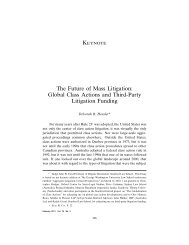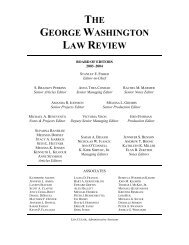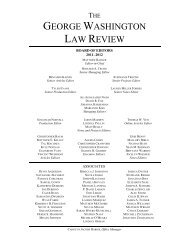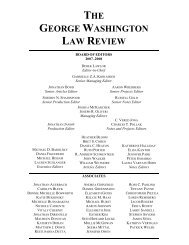View PDF - The George Washington Law Review
View PDF - The George Washington Law Review
View PDF - The George Washington Law Review
Create successful ePaper yourself
Turn your PDF publications into a flip-book with our unique Google optimized e-Paper software.
4 THE GEORGE WASHINGTON LAW REVIEWARGUENDO [Vol. 82<br />
heavily on a statistical analysis of that practice. 16 But it is a mistake to decide<br />
the constitutionality of Terry stops based on statistics. Stops are not<br />
like vitamins; each one differs from the other. Pharmaceutical firms conduct<br />
quality control by inspecting a sample of each batch of drugs because,<br />
if the manufacturing process is working properly, each batch and each drug<br />
should be the same as the others. That is not true for Terry stops, in which<br />
the facts of each stop are distinct from one another and each stop must be<br />
independently examined. 17 True, the district court analyzed a sample of<br />
nineteen stop-and-frisk cases, 18 but it is not obvious that those cases, chosen<br />
by plaintiffs’ counsel, are a representative sample. That is like evaluating<br />
the fairness of the entire New York City criminal trial process by analyzing<br />
nineteen trials chosen by defendants.<br />
Judge Scheindlin was troubled by the NYPD’s reports indicating that<br />
roughly 200,000 (at least) of the 4.4 million Terry stops, or about five percent,<br />
were unjustified. 19 Apparently, she believed that a ninety-five percent<br />
success rate meant that the NYPD had often violated the Fourth Amendment.<br />
As noted, however, that wholesale-level approach is mistaken because<br />
each case must be individually reviewed. What is more, if it were<br />
appropriate to use wholesale-level percentages to decide whether the<br />
NYPD regularly has acted lawfully, a ninety-five percent success rate<br />
should prove that it has not. <strong>The</strong> law does not require certainty that crime<br />
is afoot before a police officer can make a Terry stop, nor does the law demand<br />
that an officer know that it is more likely than not that crime is afoot.<br />
A police officer needs only “reasonable suspicion,” and that standard of<br />
proof is even less demanding than the “probable cause” standard necessary<br />
16 See id. at *15–20.<br />
17 See, e.g., United States v. Arvizu, 534 U.S. 266, 273 (2002) (“When discussing<br />
how reviewing courts should make reasonable-suspicion determinations, we have said repeatedly<br />
that they must look at the totality of the circumstances of each case to see whether<br />
the detaining officer has a particularized and objective basis for suspecting legal wrongdoing.”<br />
(internal quotation marks omitted)); Florida v. Bostick, 501 U.S. 429, 437 (1991)<br />
(“[T]he crucial test [for deciding if a person has been “seized”] is whether, taking into account<br />
all of the circumstances surrounding the encounter, the police conduct would have<br />
communicated to a reasonable person that he was not at liberty to ignore the police presence<br />
and go about his business.” (internal quotation marks omitted)); United States v. Mendenhall,<br />
446 U.S. 544, 554 (1980) (“[A] person has been ‘seized’ within the meaning of the<br />
Fourth Amendment only if, in view of all of the circumstances surrounding the incident, a<br />
reasonable person would have believed that he was not free to leave . . . .”); cf. City of Los<br />
Angeles v. Lyons, 461 U.S. 95, 108 (1983) (“We cannot agree that the odds that Lyons<br />
would not only again be stopped for a traffic violation but would also be subjected to a<br />
chokehold without any provocation whatsoever are sufficient to make out a federal case for<br />
equitable relief.” (citation omitted) (internal quotation marks omitted)).<br />
18 See Floyd, 2013 WL 4046209, at *2, *47.<br />
19 See id. at *4, *16, *18, *71.









